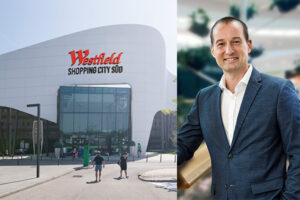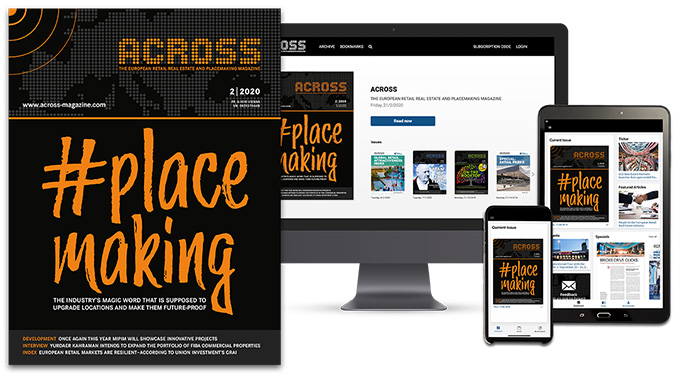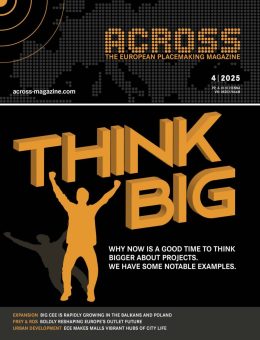Interview by
Peter Sempelmann
ACROSS: Mr. Ibrahim, you are Managing Director of the London-based design consultancy Portland Design, known for its work in retail real estate. Could you briefly introduce Portland?
Ibrahim: Portland was founded in 1987. I joined in 2000, acquired it in 2007, and in 2015 we became part of the global design firm Perkins & Will, which expanded our reach and perspective. Much of our work focuses on transport infrastructure – airports, railway stations, and urban regeneration. Transport shapes cities, so we see these as inseparable.
ACROSS: You recently launched a new offer, the “Future Innovation Day” Which can be booked via ACROSS. What’s it about?
Ibrahim: It’s about future readiness: how the next decade will transform consumers, retail, and places. How can businesses who invariably own thousands of square meters of concrete and glass develop agility in their assets and agility in their business?
“Every business must learn to disrupt itself before someone else does.”
Ibrahim Ibrahim
Managing Director Portland Design
ACROSS: Disruption comes from many sides.
Ibrahim: I would suggest even if the business, even if the asset is very, very successful, we always have to think about how to disrupt ourselves before someone else disrupts us. How can we disrupt our business to be future ready for the next ten years? I wrote a book about this, called “Future Ready Retail.”
The learnings and the process of going through writing that book has opened lots of thoughts. The innovation day sort of comes from that
ACROSS: Predicting ten years ahead is bold. How can you do that?
Ibrahim: We don’t predict technology – we study culture. Culture drives people, brands, and design.
We focus on broad cultural shifts such as “just-in-time living,” healthspan over lifespan, and the rise of wellness and sustainability as embedded expectations.
Another major shift is from consumers to fans: people want belonging, not just products. Fandom goes beyond loyalty – it’s about belonging and identity.
ACROSS: But only a few brands have real fans.
Ibrahim: True today, but fandom will define many brands in the future. We’ll segment audiences by types of fandom and emotional value, not just by purchase behavior.
Redefinig Stores and Revenue Models
ACROSS: Online shopping keeps growing. Why would people still visit stores?
Ibrahim: The motivation for going to the shop should not only be to receive items there immediately, but also to learn about them. Fandom is beyond product and not only about loyalty. Emotional connection is what drives loyalty and what drives fandom.
Physical stores are evolving. Retail is always about four things: recruitment, transaction, fulfillment, and retention.
With transactions and fulfillment moving online, stores now exist mainly for recruitment and retention – to attract and keep fans.
Physical space must behave like a media platform: a place for experience, learning, and emotional connection, not just sales.
The best stores will livestream their events and blend physical experience with digital commerce – what we call content commerce. The shop itself becomes a community hub, not just a sales floor.
ACROSS: How will this influence revenue models?
Ibrahim: This evolution also redefines how value is measured. If a store is no longer purely transactional, its success can’t be based only on product turnover or rent per square meter.
The new revenue model is media-based: it measures how effectively a place creates engagement, impressions, and emotional connection.
A store’s value will increasingly depend on its ability to attract audiences, host experiences, generate digital content, and drive brand visibility – both on-site and online.
In short, the physical space becomes a performance platform that produces attention equity, not just sales. This shift will transform leasing structures, partnerships, and how landlords and brands collaborate.
“The internet won’t kill shops –
it will liberate them.“
Ibrahim Ibrahim
Managing Director Portland Design
ACROSS: What is the role of AI in that game?
Ibrahim: AI will be the gatekeeper between consumers and brands, filtering recommendations. That makes physical spaces and real human interaction even more important. Stores are where brands build direct human connection. The internet won’t kill shops; it will liberate them.
ACROSS: But won’t the staff be replaced by robots?
Ibrahim: Both will play roles. Robots will be ubiquitous, but human engagement will remain central. Human store staff will become hosts who embody the brand, not just salespeople.
We call it the “Three L’s”: Learn, Love, Live. Associates must learn the brand, love it, and live it – becoming true advocates and influencers of the brands, of the products advertised.
ACROSS: Will these new shops be in malls or downtown areas?
Ibrahim: The line between downtown and shopping centers will blur. Every retail destination must connect to communities and evolve into mixed-use spaces – integrating retail with health, work, culture, education, leisure.
Around 40% of UK retail space – and I suppose elsewhere as well – must be reinvented in the next five years. Future success depends on creating community-focused, blended-use destinations.
This also supports the revival of high streets, another focus of my upcoming book.
Four Pillars of Future Readiness
ACROSS: Many European city centers now look the same, with identical brands everywhere. How can that change?
Ibrahim: That’s one of our biggest challenges. At Portland, we define four pillars of future readiness that every business must address to stay relevant. These pillars translate cultural shifts into practical strategy. The first pillar is “Fast – The Demand for Seamlessness.” The second pillar is “Slow – The Need for Depth and Meaning.” The third is “Local – The Return of Place.“ And the last but not least is “Belong – The Power of Community and Values.”
“Brands must not only out-innovate their competitors – they must out-behave them.”
Ibrahim Ibrahim
Managing Director Portland Design
ACROSS: Can you give a little more detail on these pillars?
Ibrahim: Certainly. So,
- Fast – The Demand for Seamlessness
Modern life is complex, precarious, and time-poor. People expect everything to be instant, easy, and frictionless – whether ordering food, booking travel, or buying luxury goods. Even affluent consumers now pay a premium for simplicity. Brands that design for speed and convenience – across physical and digital touchpoints – will thrive. - Slow – The Need for Depth and Meaning
Paradoxically, the same consumers who demand speed also seek slow moments: immersion, learning, and human connection. They want experiences that feel authentic and enriching, not transactional. This is where storytelling, craftsmanship, and community come in – allowing people to linger rather than rush. Successful brands will master both fast and slow modes. - Local – The Return of Place
The era of cookie-cutter retail is over. Consumers value uniqueness and want to see the spirit of place reflected in what they buy and where they shop. Supporting local brands or collaborations is increasingly seen as sustainable and meaningful. For global brands, localization – partnering with regional makers, adapting design or menu to local culture – is becoming essential for survival. - Belong – The Power of Community and Values
Belonging is the new currency. Consumers choose brands that align with their values and create emotional connection. This has two dimensions:- Community: creating spaces and experiences that foster fandom, participation, and shared interests.
- Values: behaving responsibly and authentically. The next competitive battleground is not price or innovation – but behavior. Brands must not only out-innovate competitors; they must out-behave them.
ACROSS: And these are also the pillars of the “Future Innovation Day?”
Ibrahim: Yes, these four pillars – Fast, Slow, Local, and Belong are the foundation of our Future Innovation Day program. Every brand or place we work with is examined through this lens to help them prepare for the next decade. Because brands that master these four pillars will be ready for the next decade.
ACROSS: Thank you, Mr. Ibrahim. It was very interesting talking to you and hearing about your future perspectives.
Ibrahim: Thank you, too. It was a pleasure.
Future Innovation Day – Preparing for the Next Decade
The Future Innovation Day is a bespoke workshop for C-level leaders – not a conference. It identifies the key “future-ready drivers” that will shape the next ten years.
The day includes:
- A keynote from Ibrahim Ibrahim on the future of retail and culture.
- A foresight session by Elisa Cecilli on cultural and consumer trends
- Data insights from Paddy Gamble, who demonstrates our AI-powered “digital ethnography” tool mapping social sentiment in any location.
- The day ends with a workshop defining the main opportunities and directions for each business.







